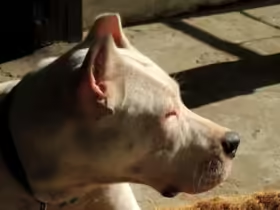Separation Anxiety in Dogs: What It Is and How to Manage It
Separation anxiety in dogs is a common behavioral issue that affects many pets, often causing distress for both dogs and their owners. Dogs are naturally social animals and form strong bonds with their human families, so it can be difficult for them when they are left alone. While some dogs adapt well to periods of solitude, others experience anxiety and panic, leading to destructive behavior and emotional stress.
In this blog, we’ll dive into the key aspects of separation anxiety, how to identify it in your dog, its causes, and most importantly, how to manage it effectively to help your dog cope better when left alone.
1. What Is Separation Anxiety in Dogs?
Separation anxiety occurs when a dog becomes overly anxious and stressed when separated from their owner or primary caregiver. Dogs with separation anxiety may exhibit signs of panic or distress when they sense that they are about to be left alone, or when they are already alone. This can manifest in destructive behaviors, excessive barking, or attempts to escape.
Separation anxiety is more than just a dislike of being alone; it’s a psychological condition that can cause significant stress for a dog. If left unaddressed, it can impact the dog’s overall well-being and the relationship between the dog and the owner.
2. Signs of Separation Anxiety
Identifying separation anxiety in your dog involves observing their behavior when you are preparing to leave, during your absence, and upon your return. There are several common signs that indicate your dog may be struggling with this condition:
2.1 Pre-Departure Anxiety
Dogs with separation anxiety often become anxious even before their owner leaves. They may:
- Follow you closely from room to room, never leaving your side.
- Show signs of distress when you pick up keys, put on shoes, or grab a bag—these actions can serve as triggers that signal you are about to leave.
- Whine, pace, or become agitated as you prepare to leave.
2.2 Behavioral Changes While Alone
Once left alone, dogs with separation anxiety may display behaviors such as:
- Destructive Behavior: Chewing furniture, shoes, or doors; digging at carpets; or scratching walls are common signs. The destructive behavior is usually focused around exit points, like doors and windows, as the dog attempts to escape.
- Excessive Barking or Howling: This behavior often starts soon after the owner leaves and continues for extended periods. It’s a vocal expression of their distress.
- Indoor Accidents: Even well-trained dogs may urinate or defecate indoors as a reaction to the stress of being alone.
- Pacing: Dogs may pace back and forth in a specific pattern, indicating restlessness and anxiety.
- Escape Attempts: Some dogs try to escape by digging at doors or windows, which can result in injury.
2.3 Extreme Attachment on Your Return
When you return, a dog with separation anxiety may act overly excited, jumping, whining, or showing signs of extreme relief. While this is not necessarily problematic, it’s an indicator that your dog was experiencing significant stress during your absence.
3. Causes of Separation Anxiety
There are several potential causes for separation anxiety in dogs. Some dogs are more prone to developing this condition due to their temperament, while others may develop it after specific life events or changes in their environment.
3.1 Change in Routine
A sudden change in a dog’s daily routine or environment can trigger separation anxiety. For example, if an owner who has spent significant time at home suddenly returns to work or travels frequently, the dog may struggle to adjust to the new routine.
3.2 Rehoming or Adoption
Dogs that have been rehomed or adopted from shelters may be more prone to separation anxiety. The trauma of being abandoned or losing their previous home can make them more anxious about being left alone again.
3.3 Loss of a Companion
Whether it’s the loss of another pet or a close family member, such a loss can trigger separation anxiety. Dogs form close bonds, and losing a companion can leave them feeling lonely and vulnerable when left by themselves.
3.4 Genetics and Temperament
Some dogs are naturally more anxious or prone to stress than others. Breeds that are highly social or form strong attachments with their owners may be more susceptible to separation anxiety. For example, dogs like Border Collies, Labrador Retrievers, and German Shepherds are known to be more prone to the condition.
4. Managing Separation Anxiety in Dogs
While separation anxiety can be challenging, there are several ways to manage and treat this condition effectively. With patience and consistency, you can help your dog feel more secure and comfortable when left alone.
4.1 Gradual Desensitization
Desensitization involves gradually getting your dog used to being alone by slowly increasing the amount of time you are away. This can help build their confidence and reduce their anxiety over time.
- Start by leaving your dog alone for short periods, such as a few minutes, and gradually increase the time.
- Ensure that your departure is calm and low-key—avoid making a big deal about leaving or returning, as this can heighten anxiety.
- Use departure cues (like putting on your shoes or grabbing keys) without actually leaving to desensitize your dog to these triggers.
4.2 Create a Safe, Comfortable Space
Provide your dog with a safe and cozy space where they feel comfortable and secure when you’re not home. This could be a favorite room, a crate, or a dog bed in a quiet area of the house.
- Crate Training: Some dogs feel more secure in a crate when left alone, as it mimics a den-like environment. However, crate training should be done gradually and with positive reinforcement to ensure your dog sees the crate as a safe place rather than a punishment.
- Comforting Items: Leave familiar items, such as your dog’s favorite toys or a piece of clothing with your scent, to help comfort them in your absence.
4.3 Provide Mental and Physical Stimulation
A tired dog is less likely to experience anxiety when left alone. Ensuring your dog has plenty of mental and physical stimulation can help reduce stress and boredom.
- Exercise: Make sure your dog gets plenty of exercise before you leave. A tired dog is more likely to relax and rest while you’re gone.
- Interactive Toys: Puzzle toys or treat-dispensing toys can keep your dog engaged and distracted, providing mental stimulation that can alleviate boredom and anxiety.
4.4 Use Calming Aids
There are several calming aids available that can help reduce your dog’s anxiety. These include:
- Calming Sprays or Diffusers: Products that release calming pheromones, such as Adaptil, can help create a soothing environment for anxious dogs.
- Calming Supplements: Natural supplements containing ingredients like L-theanine, chamomile, or valerian root can promote relaxation in dogs without sedation. Always consult your vet before introducing supplements.
- Calm Music or White Noise: Playing calming music or white noise can help create a soothing environment for your dog and block out external noises that may trigger anxiety.
4.5 Avoid Punishment
It’s essential to remember that dogs with separation anxiety are not acting out of spite or disobedience. Punishing your dog for destructive behavior or accidents will only increase their stress and worsen the problem. Instead, focus on positive reinforcement and addressing the root of the anxiety.
4.6 Consult a Veterinarian or Behaviorist
If your dog’s separation anxiety is severe, it may be necessary to consult a veterinarian or a professional dog behaviorist. They can help assess the severity of the condition and recommend appropriate treatment options.
- Behavioral Therapy: A dog behaviorist can work with you to implement a training plan specifically designed to address separation anxiety.
- Medication: In severe cases, your vet may prescribe anti-anxiety medications to help manage your dog’s symptoms while you work on behavior modification techniques.
5. Preventing Separation Anxiety
Preventing separation anxiety in dogs is often easier than treating it after it develops. Here are a few tips to help prevent this condition from taking root:
5.1 Start Early
If you’re adopting a puppy or a young dog, it’s important to teach them from an early age that it’s okay to be alone. Gradually introduce short periods of alone time and reward calm behavior with treats or praise.
5.2 Avoid Reinforcing Clinginess
While it’s natural to want to comfort your dog when they seem anxious, avoid reinforcing clingy behavior. Encourage your dog to have some independence, even when you’re home, by providing them with their own space and activities.
5.3 Stick to a Routine
Dogs thrive on routine, and establishing a consistent daily schedule can help reduce anxiety. Stick to regular feeding, exercise, and alone-time routines, so your dog knows what to expect each day.
5.4 Practice Low-Key Departures
When leaving the house, avoid making a big fuss or long goodbyes. Keeping departures and returns calm and uneventful can help reduce the anxiety your dog feels around your comings and goings.











Leave a Reply